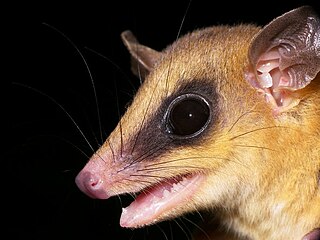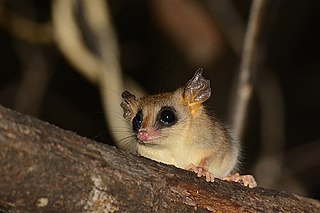
Opossums are members of the marsupial order Didelphimorphia endemic to the Americas. The largest order of marsupials in the Western Hemisphere, it comprises 126 species in 18 genera. Opossums originated in South America and entered North America in the Great American Interchange following the connection of North and South America.

Alston's mouse opossum, also known as Alston's opossum, is a medium-sized pouchless marsupial of the family Didelphidae. It is arboreal and nocturnal, inhabiting forests from Belize to northern Colombia. The main components of its diet are insects and fruits, but it may also eat small rodents, lizards, and bird eggs. It was formerly assigned to the genus Micoureus, which was made a subgenus of Marmosa in 2009.

The woolly mouse opossum or long-furred woolly mouse opossum, known locally as the cuíca, is a South American marsupial of the family Didelphidae. Its range includes central Colombia, Venezuela, French Guiana, Guyana, Suriname, eastern Peru, northern Bolivia, and northern Brazil. It was formerly assigned to the genus Micoureus, which was made a subgenus of Marmosa in 2009.

The bare-tailed woolly mouse opossum or short-furred woolly mouse opossum is a South American marsupial of the family Didelphidae. Its range includes Brazil, Colombia, Ecuador, Peru, and Bolivia. It is found in tropical rainforest in the westernmost portion of the Amazon Basin and the eastern foothills of the Andes, at elevations up to 1634 m. It was formerly assigned to the genus Micoureus, which was made a subgenus of Marmosa in 2009.

The Chacoan pygmy opossum is a recently described genus and species of didelphimorph marsupial. The only species in Chacodelphys, C. formosa, was known until 2004 from only one specimen collected in 1920 in the Chaco of Formosa Province, Argentina. The species is gaining popularity as a pocket pet.

The bushy-tailed opossum is an opossum from South America. It was first described by English zoologist Oldfield Thomas in 1912. It is a medium-sized opossum characterized by a large, oval, dark ears, fawn to cinnamon coat with a buff to gray underside, grayish limbs, and a furry tail. Little is known of the behavior of the bushy-tailed opossum; less than 25 specimens are known. It appears to be arboreal (tree-living), nocturnal and solitary. The diet probably comprises insects, eggs and plant material. This opossum has been captured from heavy, humid, tropical forests; it has been reported from Bolivia, Brazil, Colombia, Ecuador and Peru. The IUCN classifies it as least concern.

The 27 species in the genus Marmosa are relatively small Neotropical members of the family Didelphidae. This genus is one of three that are known as mouse opossums. The others are Thylamys and Tlacuatzin, the grayish mouse opossum. Members of the genus Marmosops used to be called "slender mouse opossums", but are now just called "slender opossums". The thirteen members of the Marmosa subgenus Micoureus, known as woolly mouse opossums, were formerly considered to be a separate genus, but were moved into Marmosa in 2009. Based on a comparison of sequences of one mitochondrial and three nuclear genes, three new subgenera, Eomarmosa, Exulomarmosa and Stegomarmosa, were recognized by Voss et al. in 2014. Eomarmosa and Exulomarmosa, as well as Marmosa and Micoureus, are thought to be sister taxa, while Stegomarmosa is viewed as sister to Marmosa plus Micoureus. Exulomarmosa is a mostly trans-Andean clade.

The white-bellied slender opossum is a species of opossum from South America. It is found in Bolivia, Brazil, Ecuador and Peru.
Cerradomys marinhus, also known as Marinho's rice rat, is a rodent species from South America. It is found in Minas Gerais, Brazil. It was formerly known as Oryzomys marinhus, but was transferred to the new genus Cerradomys in 2006.
Cerradomys subflavus, also known as the terraced rice rat or flavescent oryzomys, is a rodent species from South America in the genus Cerradomys. It is found in the states of Goiás, São Paulo, and Minas Gerais, Brazil. Populations in Bolivia, Paraguay, and elsewhere in Brazil that were previously placed in this species are now classified as various other species of Cerradomys.

Gracilinanus is a genus of opossum in the family Didelphidae. It was separated from the genus Marmosa in 1989, and has since had the genera Cryptonanus, Chacodelphys, and Hyladelphys removed from it.

Bishop's slender opossum is a small, arboreal marsupial opossum native to Brazil, Peru, and Bolivia. It somewhat resembles a placental rat or shrew.
The red-bellied gracile opossum is an extinct species of opossum that was native to Jujuy Province in northwest Argentina. Its forest habitat has been destroyed, and it was last seen in 1962.

Agricola's gracile opossum is a species of opossum in the family Didelphidae endemic to eastern Brazil. Its habitat is the caatinga and cerrado. While its conservation status has not been determined, expansion of agricultural activities is leading to loss of some of its habitat. There are several protected areas in the species' range but it has not been collected from these areas. The species is named after Brazilian physician Ernani Agricola.

The chacoan gracile opossum is a species of opossum in the family Didelphidae. It is native to Argentina, Brazil and Paraguay. Its habitat is seasonally flooded grasslands and forests in and near the Gran Chaco.

The Guahiba gracile opossum is a species of opossum in the family Didelphidae. It is endemic to southern Brazil, where it is known only from three islands, Guahiba, São Lourenço, and Taquara, in the state of Rio Grande do Sul. The poorly studied species is presumed to inhabit subtropical forests, and thus to be threatened by deforestation.

The Quechuan mouse opossum is a South American opossum species of the family Didelphidae. It is known from two areas of montane forest on the eastern slopes of the Andes in Peru, at altitudes from 300 to 2700 m. The type locality in the Valle de Occobamba is in the southern area, in Cuzco Region, while the northern area is in the vicinity of Moyobamba in San Martín Region. The true range may be more extensive and possibly extends into Bolivia. The northern area has suffered from habitat destruction, but the southern area is not seriously degraded.
Cerradomys maracajuensis, also known as the Maracaju oryzomys, is a rodent species from South America. It is terrestrial and is found in gallery forests in Bolivia, Paraguay and nearby Brazil and Peru. It was first discovered near the Brazilian city of Maracaju.

Cryptonanus is a genus of opossums from South America. It includes five species found from Bolivia to Uruguay and eastern Brazil, one of which is now extinct. Although the first species were discovered in 1931, the genus was not recognized as distinct from Gracilinanus until 2005. It includes small opossums with generally grayish, sometimes reddish, fur that are mainly distinguished from other opossums by characters of the skull.















